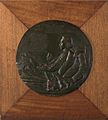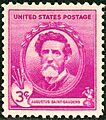Augustus Saint-Gaudens facts for kids
Quick facts for kids
Augustus Saint-Gaudens
|
|
|---|---|
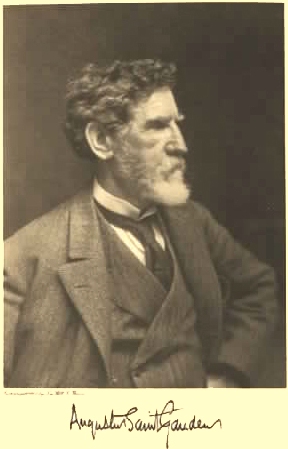
Augustus Saint-Gaudens, 1905
|
|
| Born | March 1, 1848 |
| Died | August 3, 1907 (aged 59) |
| Nationality | American |
| Education | Cooper Union, National Academy of Design, École des Beaux-Arts. |
| Known for | Sculpture |
| Movement | The "Be Silent Be Still" |
| Spouse(s) | Augusta |
Augustus Saint-Gaudens (March 1, 1848 – August 3, 1907) was a famous American sculptor. He was known for his beautiful and realistic statues. He grew up in New York City and later studied art in Europe.
When he returned to New York, he became very successful. He created many important monuments. These often honored heroes from the American Civil War. Many of his sculptures are still standing today. Some of his most famous works include the Robert Gould Shaw Memorial in Boston. He also made statues of Abraham Lincoln: The Man. He created grand horse-riding statues of Civil War generals. These include the General John Logan Memorial in Chicago and William Tecumseh Sherman in New York. He also made the well-known statue The Puritan.
Saint-Gaudens also designed coins. He created the $20 Saint Gaudens Double Eagle gold coin. This coin is considered one of the most beautiful American coins ever made. He also designed the $10 "Indian Head" gold eagle. Both were minted from 1907 to 1933. Later in his life, he started an art community called the "Cornish Art Colony". Many talented artists, writers, and architects joined him there. His brother, Louis Saint-Gaudens, was also a sculptor. They sometimes worked together.
Contents
Early Life and Art Training
Augustus Saint-Gaudens was born in Dublin, Ireland. His mother was Irish and his father was French. His father, Bernard Paul Ernest Saint-Gaudens, was a shoemaker. When Augustus was six months old, his family moved to America. He grew up in New York City.
In 1861, when he was 13, he started working as an apprentice for a cameo-cutter. Cameos are small carvings, often on shells or stones. He also took evening art classes at the Cooper Union in New York City. Two years later, he worked for another cameo cutter. He also joined the National Academy of Design to study art.
When he was 19, his apprenticeship ended. He then traveled to Paris in 1867. There, he studied at the École des Beaux-Arts. This was a very famous art school. In 1870, he moved to Rome to study art and architecture. He also started getting his first art jobs there. In Rome, he met Augusta Fisher Homer, an American art student. They got married on June 1, 1877. They had one son named Homer Saint-Gaudens.
In 1874, a New York reformer named Edwards Pierrepont hired Saint-Gaudens. He wanted a marble bust of himself. Pierrepont was very particular about how his head should look. Saint-Gaudens found him a difficult client.
In 1876, Saint-Gaudens won a big job. He was asked to create a bronze memorial for David Farragut. Farragut was a famous admiral. Saint-Gaudens worked with Stanford White, an architect, on this project. The memorial was unveiled in 1881 in Madison Square Park in New York City.
Saint-Gaudens worked with Stanford White again later. From 1892 to 1894, he created Diana. This statue was a weather vane for the second Madison Square Garden building. It stood on a 300-foot-high tower. This made Diana the highest point in New York City at the time. It was also the first statue in that area to be lit by electricity at night.
Saint-Gaudens was also part of several art clubs in New York City. These included the Tilers, The Lambs, Salmagundi Club, and The National Arts Club.
Sculptures Honoring the Civil War
In 1876, Saint-Gaudens got his first major commission. It was for a monument to Civil War Admiral David Farragut. This monument is in Madison Square in New York. His friend Stanford White designed the setting for it. When it was shown in 1881, people loved its realistic style. This made Saint-Gaudens very famous.
After that, he received many more commissions. One important work was the huge Abraham Lincoln: The Man. This statue is in Lincoln Park, Chicago. It was created between 1884 and 1887. Many people think it is the best portrait statue in the United States. A copy of it is at Lincoln's tomb in Springfield, Illinois. Another copy stands in Parliament Square, London.
He also created many other memorials and busts. These include the Adams Memorial and the Peter Cooper Monument.
Perhaps his greatest work is the bronze relief sculpture. This is the Robert Gould Shaw Memorial on Boston Common. Saint-Gaudens worked on it for 14 years, from 1884 to 1897. He even continued to work on it after it was unveiled.
He also made two impressive horse-riding statues of Civil War generals. One is for General John A. Logan in Chicago, finished in 1897. The other is for William Tecumseh Sherman in New York, completed in 1903. For the Sherman statue, an African-American model named Hettie Anderson posed as an allegorical Victory. The way African-American soldiers are shown in the Shaw memorial is special. It shows them realistically, which was rare in art at that time.
For Lincoln's 100th birthday in 1909, Saint-Gaudens made another statue of the president. This one shows Lincoln seated. It is called Abraham Lincoln: The Head of State. It is in Grant Park in Chicago. Saint-Gaudens designed it and started casting it before he died. His workshop finished the statue. The head of this statue was used for a commemorative postage stamp. This stamp was issued on the 100th anniversary of Lincoln's birth.
Other Important Works
Saint-Gaudens also created the statue for the monument of Charles Stewart Parnell. This statue was placed in Dublin's O'Connell Street in 1911.
In 1887, he made sketches for a medallion of Robert Louis Stevenson. Stevenson was a famous writer. The medallion showed Stevenson writing in bed because he was in poor health. This medallion was later used for Stevenson's memorial in St. Giles' Cathedral in Edinburgh. Stevenson's cousin said it was the best portrait of Stevenson. Saint-Gaudens admired Stevenson very much.
Saint-Gaudens was also asked to create many medals. These included medals for special events and groups. This shows how respected he was by other artists and people of his time.
A statue of Robert Randall, a generous person, is in the gardens of Sailors' Snug Harbor in New York. There is also a statue of Marcus Daly, a "copper king," in Butte, Montana. A statue of former Congressman and New York Governor Roswell Pettibone Flower was put up in 1902 in Watertown, New York.
Teacher and Mentor
Because he was so well-known, Saint-Gaudens had many students. He was a kind and helpful teacher. He taught young artists privately. He also taught at the Art Students League of New York. He had many assistants who learned from him.
He also gave advice for the World's Columbian Exposition in 1893. This was a big world's fair. He strongly supported the American Academy in Rome. He was also part of the McMillan Commission. This group helped bring back the original plan for the nation's capital.
Augustus Saint-Gaudens was especially good at making small, detailed portraits. These were often in very low relief, like old Italian art. He influenced many other sculptors, including Jerome Connor.
Many talented sculptors of the next generation learned from Saint-Gaudens. Some of his assistants included James Earle Fraser, Frances Grimes, Henry Hering, Charles Keck, Frederick MacMonnies, and his brother Louis Saint-Gaudens.
Coin Designs
Saint-Gaudens called his early relief portraits "medallions." He was very interested in the art of coin design. His $20 gold piece, called the double eagle, is famous. He designed it for the US Mint between 1905 and 1907. Even though it was changed for minting, it is still thought to be one of the most beautiful American coins ever made.
Theodore Roosevelt, the president, chose Saint-Gaudens to redesign the nation's coins. Saint-Gaudens created a $20 gold piece with very high details. This "ultra high-relief" coin needed many strikes to make the details stand out. Only about 20 of these were made in 1907. They were hard to stack and not good for everyday use. Today, these coins are very rare and valuable.
The coin was then changed to a "high relief" version. This still needed many strikes but fewer than the ultra high-relief. About 12,317 of these were made. They are also very popular with collectors today. Finally, the coin was changed to a normal-relief version. This was minted from 1907 to 1933.
Saint-Gaudens' design for the front of the coin was used again in 1986. It appears on the American Gold Eagle gold bullion coins. In 2009, the U.S. Mint also issued a new "ultra-high relief" $20 gold coin.
Later Life and the Cornish Colony
In 1900, Saint-Gaudens was diagnosed with cancer. He decided to live at his home in Cornish, New Hampshire. He had been spending summers there since 1885. Even though he was sick, he kept working. He continued to create many sculptures and reliefs.
In 1901, he joined the Senate Park Commission. This group helped redesign the Mall and park system in Washington, D.C. In 1904, he was one of the first seven people chosen for the American Academy of Arts and Letters. That same year, his large studio burned down. He lost many important things, including his letters, sketchbooks, and works in progress.
The Cornish Art Colony was a lively place. Saint-Gaudens and his brother Louis attracted many artists there. Famous artists like Maxfield Parrish and Kenyon Cox were part of it. Architect Charles A. Platt and sculptor Paul Manship also joined. Other members included painters Thomas Dewing and George de Forest Brush. The American novelist Winston Churchill was also part of the colony. After Saint-Gaudens died in 1907, the colony slowly faded away. His house and gardens are now a museum called the Saint-Gaudens National Historic Site.
Saint-Gaudens received many honors during his life. In 1896, he became a member of the American Academy of Arts and Sciences. In 1901, the French government gave him a special award, the Officier de la Légion d'honneur. In 1920, after he died, he was chosen for the Hall of Fame for Great Americans. In 1940, his picture appeared on a U.S. postage stamp.
Legacy and Honors
During World War II, a ship was named in his honor. It was called the Liberty ship SS Augustus Saint-Gaudens.
In 1940, the U.S. Post Office released a series of postage stamps. These stamps honored famous Americans. Augustus Saint-Gaudens was chosen for the 'Artists' category. His stamp was first issued in New York City on September 16, 1940.
PS40, a school in New York City, is named after Saint-Gaudens.
Many public collections have works by Augustus Saint-Gaudens. Some of these include:
|
|
Selected Works
| Title | Image | Year | Location | Material | Notes |
|---|---|---|---|---|---|
| Admiral David Glasgow Farragut | 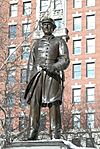 |
1881 | Madison Square Park NYC | Bronze & granite | exedra designed by Stanford White |
| The Puritan |  |
1887 | ‘’’Merrick Park’’’, near Quadrangle Springfield, Massachusetts | Bronze & granite | |
| Standing Lincoln | 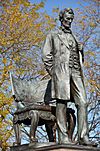 |
1887 | Lincoln Park in Chicago, Illinois | Bronze & granite | architectural setting by Stanford White other casting located in Parliament Square, London and Parque Lincoln, Mexico City |
| ‘'General John Logan Memorial’' |  |
1897 | Grant Park in Chicago, Illinois | Bronze & granite | architectural setting by Stanford White, horse modeled by Alexander Phimister Proctor |
| Robert Gould Shaw Memorial |  |
1897 | Boston Common, Boston, Massachusetts | Bronze & granite | architectural elements designed by Charles Follen McKim |
| Adams Memorial | 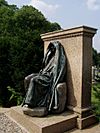 |
1891 | Rock Creek Cemetery, Washington, D.C. | Bronze & granite | architectural setting by Stanford White |
| William Tecumseh Sherman |  |
1903 | Grand Army Plaza, Manhattan | Bronze & granite | granite pedestal designed by Charles Follen McKim |
| Henry W. Maxwell Memorial |  |
1903 | Grand Army Plaza, Brooklyn | Bronze & granite | Assisted by Albert Jaegers |
| Seated Lincoln | 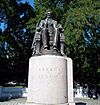 |
1908, unveiled in 1926 |
Grant Park in Chicago, Illinois | Bronze & granite | architectural setting by Stanford White, Laurence Grant White and Graham, Anderson, Probst and White |
Gallery
-
Portrait of Robert Louis Stevenson, 1887–88, Honolulu Museum of Art.
-
Hiawatha, Marble (1872), Metropolitan Museum of Art.
-
The Puritan, bronze (1883–1886), outdoors in Springfield, Massachusetts, and indoors at the Metropolitan Museum of Art and the National Gallery of Art.
-
Detail of Shaw Memorial plaster model (1884–87), National Gallery of Art.
-
Mrs. Schuyler Van Rensselaer (Mariana Griswold), Bronze (1888), Metropolitan Museum of Art.
-
Detail of Adams Memorial, Rock Creek Cemetery, Washington, DC (1891).
-
Peter Cooper Monument in front of the Cooper Union, Cooper Square, New York, NY (1897).
-
Amor Caritas, Bronze (1898), Cleveland Museum of Art.
-
Plaque of Robert Charles Billings, Boston Public Library, Boston, Massachusetts (1899).
-
Marcus Daly statue (1906), Montana Tech campus, Butte, Montana
-
Statue of Phillips Brooks, Trinity Church, Boston (1907–10, completed by Grimes, Ward and Hering).
Images for kids
-
Portrait of Augustus's wife Augusta and their son, Homer Saint-Gaudens, by John Singer Sargent, 1890.
-
Abraham Lincoln: The Man in Lincoln Park, Chicago (1887)
-
Adams Memorial, Rock Creek Cemetery, Washington, DC (1891).
See also
 In Spanish: Augustus Saint-Gaudens para niños
In Spanish: Augustus Saint-Gaudens para niños



